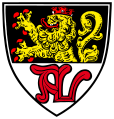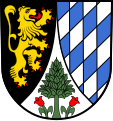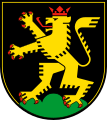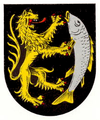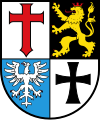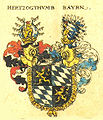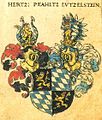Palatinate lion
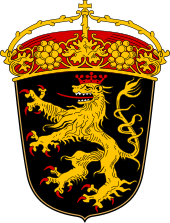




The Palatinate lion is a common figure in heraldry (see also: lion as heraldic animal ). It was originally part of the Wittelsbach family coat of arms and can now be found in many coats of arms of municipalities, districts and countries in southern Germany, Alsace and the Innviertel .
to form
The lion is golden in a black field, turned to the right, crowned, bearded and armored in red. Originally uncrowned, the lion was first depicted with a red crown in the Zurich coat of arms at the beginning of the 14th century . She probably goes back to the prominent position that the Elector of the Palatinate as imperial vicar since the Golden Bull held from 1356th
In addition to these two main forms, there are a large number of variants. Many villages were sealed with the symbols of the ruling family. In order to reduce confusion, details of the coat of arms approvals were often changed. Other colors were also used in individual cases in order to comply with the heraldic rule of colors .
- Palatinate lion in the coat of arms of today's communities
history
Time of origin
The Palatinate lion is first recorded in the Count Palatine near Rhine under the Wittelsbach Count Palatine Otto the Illustrious in his equestrian seal from 1229. However, the use of the symbol is likely to be older; it probably goes back to the predecessors of the Wittelsbach family, the Guelph Count Palatine Heinrich the Elder and Heinrich the Younger , who ruled from 1195 to 1214 . Prior to that, had the Staufer Palatine Konrad leave, father of Henry the Elder, shape around 1190 coins with a lion image. The colors of the Hohenstaufen were also gold and black.
Time of the Wittelsbachers
After the Bavarian Duke Ludwig was enfeoffed in 1214 with the Palatinate County near Rhine, Duke Otto II von Baiern inherited the County of Bogen and thus its white and blue diamond coat of arms in the middle of the 13th century . For centuries, the golden lion in the black field and the white and blue diamonds served as the family coat of arms of the old Bavarian and Palatinate Wittelsbachers. It was not until the 16th century that the distinction between the lion for the Palatinate and the diamond for Bavaria slowly took hold.
In Siebmacher's coat of arms book from 1605, four color drawings with the Palatinate lion are shown. They show the coats of arms of the Electorate of Palatinate and the Duchies of Bavaria , Palatinate-Neuburg and Palatinate-Lützelstein .
After the dissolution of the Palatine electorate as a result of Reichsdeputationshauptschluss conclusion in 1803 of the Palatine Lion took off in 1816 in the Bavarian crest now the left-bank part of the Kingdom of Bavaria , the Rhine district , who in 1835 at the direction of Ludwig I in Palatinate has been renamed.
After the Second World War
After the Second World War , the Palatinate lion reappeared as a regional symbol for the Palatinate , for example on postage stamps in the French occupation zone . After the founding of the federal state of Rhineland-Palatinate in 1946, to which the Palatinate has belonged since then, the Palatinate lion assumed a central position in the state coat of arms of Rhineland-Palatinate . Further components of the coat of arms of Rhineland-Palatinate are the Mainz wheel and the Trier cross . The half-official coat of arms of the governmental district of Palatinate , which existed from 1946 to 1968, also bore the Palatinate Lion, which, after the inclusion of former Electoral Mainz and Electoral Trier territories, symbolized the area of today's Palatinate.
In addition, the lion can now be found in the coat of arms of three other federal states: in the coat of arms of Bavaria (uncrowned), in the coat of arms of the Saarland and in the coat of arms of Baden-Württemberg ; like Rhineland-Palatinate, all three federal states comprise former Electoral Palatinate territory. In the Bavarian state coat of arms, the lion has stood in the heraldic upper right field since 1950 for the Upper Palatinate , which once also belonged to the ancestral regions of Wittelsbach. On the Bavarian coat of arms, the Palatinate lion was in the second field from 1923 to 1934, and since 1950 it has been in the first - as with the national coat of arms.
Representations with the Palatinate lion
coat of arms
See: List of coats of arms with the Palatinate lion
Flags
The flag of the King of Bavaria , in use from 1806 to 1919, is square with the Palatinate lion in the second and third part of the flag, fields 1 and 4 show the white and blue diamonds . Since 1909, with the Palatinate lion as the main character, there has also been the unofficial Palatinate flag , which is widespread in the region.
seal
Otto Posse describes in the book The Seal of the German Emperors and Kings seals of the Electoral Palatinate Imperial Vicariate:
- 1558: The Count Palatine in full armor on horseback with corresponding details (weapon, flag), a princely palace in the background, three coats of arms on the horse cover . The one on the right shows the Palatinate lion, the one in the middle the orb for the ore clerk's office , the one on the left the Bavarian wake.
- 1612: The Palatinate lion is shown on three coats of arms on the right, the imperial orb in the middle and the Bavarian Wecken on the left. A crowned lion is depicted on a helmet above, with the year 16 and 12 on both sides of the lion.
Stone carvings
- The archway of the Hospital of the Holy Spirit in Bad Mergentheim bears the coat of arms of Prince-Bishop Franz Ludwig von Pfalz-Neuburg with a Palatinate lion and a blue lion, reinforced with gold and also crowned, in silver, which stands for the County of Veldenz .
- The Schriesheim coat of arms, awarded to the place in 1896 after a seal from 1381, is held by the Palatinate lion. The detail was created from red Main sandstone in 1964 for an eight-sided trough of the city fountain by a stonemason company from the city on the occasion of the city's designation.
- In front of the portal of the residence in Neumarkt there are two stone lions with the coat of arms of Elector Friedrich II in their paws. This coat of arms again contained a representation of the lion.
Paintings
The Wendalinus basilica in the Saarland district town of St. Wendel has late medieval vault paintings from around 1463/1464, which contain the coats of arms of the then highest spiritual and secular representatives of the Holy Roman Empire . Among the 15 coats of arms, those of the Archbishop of Cologne and the Count Palatine near Rhine show the Palatinate Lion.
See also
literature
- Karl Heinz Debus: The great book of arms of the Palatinate. Gräber, Neustadt an der Weinstrasse 1988, ISBN 3-9801574-2-3 .
- Alfons Friderichs: Book of arms of the district of Cochem-Zell. F. Burgard, Bad Bertrich 2001, ISBN 3-00-008064-3 .
- Herwig John, Gabriele Wüst: Wappenbuch Rhein-Neckar-Kreis (= Rhein-Neckar-Kreis. Historical writings. Vol. 1). Regional culture publishing house, Ubstadt-Weiher 1996, ISBN 3-929366-27-4 .
- Arnold Rabbow, Dieter Gube: State coat of arms of Rhineland-Palatinate (= leaves to the state. Rhineland-Palatinate. 1, 1999, ZDB -ID 2000338-9 ). State Center for Political Education Rhineland-Palatinate, Mainz 1999, ( digitized version (PDF; 562 kB) ).
Web links
References and comments
- ↑ Albig: The Palatine Lion was supplemented by a stylized, the letter A similar boom .
- ↑ Bammental: The coat of arms bears the lion and rhombuses of the Electoral Palatinate.
- ↑ Heltersberg: Compared to Waldfischbach, the position of the paws has been changed.
- ↑ Mannheim: The Palatinate lion was supplemented by a wolf tang , probably a stain mark .
- ↑ Meckenheim: An M was added to the coat of arms of the Electoral Palatinate .
- ^ Neumarkt district: The Palatinate lion was supplemented by the two red lions of the Lords of Wolfstein-Sulzbürg .
- ↑ Rhein-Neckar-Kreis: The divided wave bar stands for the rivers Rhine and Neckar , the tinging of the lion has been changed.
- ↑ Schwetzingen: The ring is derived from a wagon wheel, the seal of a local nobleman.
- ↑ Schriesheim: The arrows symbolize the Strahlberger who were defeated by the Palatinate Lion.
- ↑ Selzen: The Palatinate lion and the silver key of the diocese of Worms stand for the divided rule over the place.
- ↑ Worms-Ibersheim: The Palatinate Lion was supplemented by the red cross of the Lorsch monastery , the black cross of the Teutonic Order and the Leininger eagle.
- ↑ a b Description of the coat of arms of Rhineland-Palatinate (PDF; 562 kB).
- ↑ Otto Posse : The seals of the German emperors and kings. Volume 5. von Baensch Foundation, Dresden 1913, p. 126 f., ( Full text on Wikisource ).
- ^ Anton Franziskus: St. Wendelinus-Basilika zu St. Wendel, Munich and Berlin 2007, p. 16.
